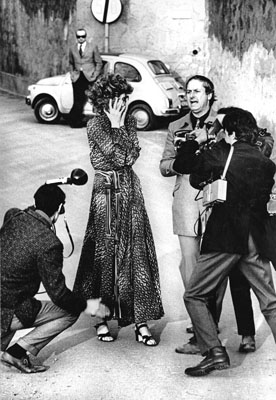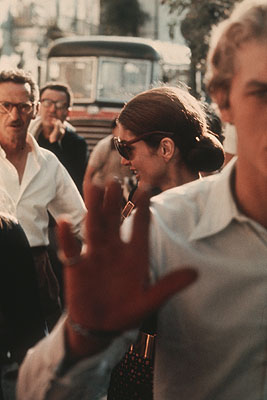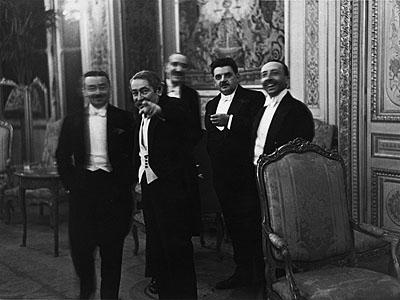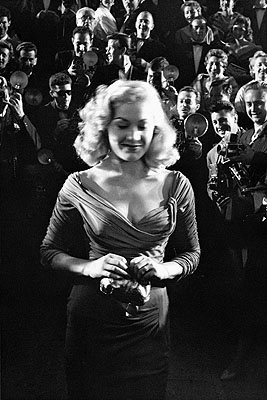
Pigozzi and the Paparazzi
Daniel Angeli » Ron Galella » Helmut Newton » Edward Quinn » Erich Salomon » Tazio Secchiaroli » Weegee »
Exhibition: 20 Jun – 16 Nov 2008
Helmut Newton Stiftung
Jebensstr. 2
10623 Berlin

Helmut Newton Foundation
Jebensstr. 2
10623 Berlin
+49 (0)30-31864856
info@helmut-newton-foundation.org
www.helmutnewton.com
Tue-Sun 11-19, Thu 11-20

Mit etwa 350 Schwarz-Weiß- und Farbphotographien, teilweise als signierte vintage prints, wird den "bad boys" des Mediums Photographie erstmals in Deutschland eine so umfangreiche Präsentation gewidmet. Mit Erich Salomon, Weegee, Ron Galella, Edward Quinn, Daniel Angeli, Tazio Secchiaroli, Jean Pigozzi sowie Helmut Newton werden in dieser Ausstellung Vorläufer wie Hauptvertreter der "klassischen" Zeit der Paparazzi-Photographie präsentiert. Gleichzeitig wird das Phänomen künstlerisch kommentiert und paraphrasiert. So wird anhand von Schnappschüssen aus sechs Dekaden die Geschichte dieser Art von Prominentenphotographie, die mit exklusiven Berichten über den Jetset immer wieder für Auflagensteigerungen der Yellow Press sorgte, illustriert und medienreflexiv untersucht. With the current exhibition the "bad boys" of photography are the subject of an extensive show for the first time in Germany. Paparazzi photography is an aggressive form of photojournalism, particularly today when the famous names in show business are hunted down and pushed into dangerous situations for the sake of getting the most interesting picture possible. In the 1960's and 1970's, the "classic" era of the paparazzi, the combination of voyeurism and exhibitionism, whereby photographers lie in wait for the stars to make their public appearance, was less strident and loud. Inventiveness, speed and persistence, along with a touch of cheekiness—put to use at the Cannes Film Festival, or on the Via Veneto in Rome—was usually enough to guarantee good results. The exhibition "Pigozzi and the Paparazzi" concentrates on snapshots and portraits of famous people from this era and offers us a glimpse of how the mythic aura of the stars was dismantled by showing them going about their daily lives. We encounter Alain Delon and Prince Charles, Mick Jagger and Woody Allen, Sophia Loren and Grace Kelly, Brigitte Bardot and Gina Lollobrigida at parties, on the street, at the beach and so on. Most of these pictures were taken "from a safe distance" with the photographer going unnoticed. Nevertheless, once in a while a fight would break out between the hunter and the hunted when a photographer got too close or was discovered in his hiding-place. For example, the photographer Ron Galella lost several teeth when he suffered a well-aimed punch from Marlon Brando; thereafter he often wore an American Football helmet any time he expected to come across Brando at a public event. In hardly any of these photographs was there ever time for the subject to strike a pose. Most of the stars were caught by surprise, and to a certain extent many of these images were "stolen". Contemporary paparazzi images are consciously excluded from the exhibition, since it is hard to discern any real photographic quality in the flood of images shot by packs of photographers, whose methods have become increasingly ruthless and their equipment mechanized. Today, more so than ever, magazines newspapers are highly interested in this kind of imagery. Regardless of quality and originality, it is sensation that counts. (...) Presenting approximately 350 B/W and colour prints by Salomon, Weegee, Galella, Quinn, Angeli, Secchiaroli, Pigozzi and Newton, the exhibition displays the forerunners and central figures of the "classic" period of Paparrazi Photography—and provides a visual commentary about the evolution of this phenomenon. The exhibition offers an overview and critical look at the history of a photographic genre dedicated to fame and sensationalism. A genre that continues to feed the Yellow Press with exclusive reports on the comings and goings of the jet set in order to push the sales of their publications ever higher. There will always be paparazzi photographs that cross over into celebrity and portrait photography. Jean Pigozzi, the photographer included in the exhibition title, has been able to cultivate the kind of intensive and intimate relationship with the rich and the famous that is so desperately sought after by the paparazzi at large. He too penetrates into their private sphere, yet the stars generally acquiesce to the photographic unmasking with a smile. Being befriended with many famous people in the international social and cultural scene, he has been making candid portraits of prominent individuals at private locations since the 1970's. An unusual aspect of his work is his double portrait series Pigozzi & Co. In this ongoing project he appears together with a musician or an actor friend, the two posed with their heads, often touching, in a close-cropped composition. The photographer's arm has been stretched outwards to aim the camera at himself and the person he is with. These are images from daily life, in which Pigozzi poses as friend and fan. In this manner he subtly takes the hunger for celebrity images to an absurd extreme and in doing so he ingeniously plays to this desire when he publishes the images in books, or exhibits them, as he does here at the HNF. Now, at the beginning of the 21st century most paparazzi are no longer working in Rome, but in Los Angeles. It is there that Hollywood functions as the world's largest production mechanism for the creation of images and illusions. While stars need, and sometimes like, to bathe in the flashing lights of the cameras during official events like film award ceremonies or charity parties, after the official appearance is over the camera shifts from its function as a promotional medium, into that of a weapon. It is a weapon gladly wielded by the eager hands and hungry eyes of the paparazzi. The photos captured during such off-festival encounters are occasionally deeply controversial, yet often very highly prized. Matthias Harder

